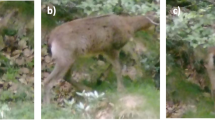Abstract
Technology is increasingly used in Nature Reserves and National Parks around the world to support conservation efforts. Endangered species, such as the Eurasian Lynx (Lynx lynx), are monitored by a network of automatic photo traps. Yet, this method produces vast amounts of data, which needs to be prepared, analyzed and interpreted. Therefore, researchers working in this area increasingly need support to process this incoming information. One opportunity is to seek support from volunteer Citizen Scientists who can help label the data, however, it is challenging to retain their interest. Another way is to automate the process with image recognition using convolutional neural networks. During the panel, we will discuss considerations related to nature research and conservation as well as opportunities for the use of Citizen Science and Machine Learning to expedite the process of data preparation, labelling and analysis.
Access this chapter
Tax calculation will be finalised at checkout
Purchases are for personal use only
Similar content being viewed by others
Notes
- 1.
During our citizen science workshops with older adults we have shown a series of video recordings depicting photo trap field work in a Lynx conservation project filmed by J. Loch to see whether they would constitute an attractive edutainment reward.
References
Drakshayini, Mohan, S.T., Swathi, M., Nanjundeshwara, K.: Leveraging machine learning and remote sensing for wildlife conservation: a comprehensive review. Int. J. Adv. Res. 11, 636–647 (2023). https://doi.org/10.21474/IJAR01/17110
Andersson, S., Nilsson, L., Groth, I., Bergström, G.: Floral scents in butterfly-pollinated plants: possible convergence in chemical composition. Botan. J. Linnean Soc. 140, 129–153 (2002). https://doi.org/10.1046/j.1095-8339.2002.00068.x
Bloch, G., Bar Shai, N., Cytter, Y., Green, R.: Time is honey: circadian clocks of bees and flowers and how their interactions may influence ecological communities. Phil. Trans. Royal Soc. B: Biol. Sci. 372, 20160256 (2017). https://doi.org/10.1098/rstb.2016.0256
Brady, D., Saviane, A., Cappellozza, S., Sandrelli, F.: The circadian clock in lepidoptera. Front. Physiol. 12, 776826 (2021). https://doi.org/10.3389/fphys.2021.776826
Brattström, O., Shapoval, A., Wassenaar, L., Hobson, K., Akesson, S.: Geographic origin and migration phenology of European red admirals (vanessa atalanta) as revealed by stable isotopes. Movement Ecol. 6 (2018). https://doi.org/10.1186/s40462-018-0143-3
Fenske, M., Imaizumi, T.: Circadian rhythms in floral scent emission. Front. Plant Sci. 7 (2016). https://doi.org/10.3389/fpls.2016.00462
Fenske, M., Nguyen, L., Horn, E., Riffell, J., Imaizumi, T.: Circadian clocks of both plants and pollinators influence flower seeking behavior of the pollinator hawkmoth manduca sexta. Sci. Rep. 8 (2018). https://doi.org/10.1038/s41598-018-21251-x
Norouzzadeh, M.S., et al.: Automatically identifying, counting, and describing wild animals in camera-trap images with deep learning. Proc. Natl. Acad. Sci. 115(25), E5716–E5725 (2018). https://doi.org/10.1073/pnas.1719367115. https://www.pnas.org/doi/abs/10.1073/pnas.1719367115
Parsons, M., et al.: Why are predator cues in the field not more evocative? a ‘real world’ assay elicits subtle, but meaningful, responses by wild rodents to predator scents. Front. Ecol. Evolut. 10, 1054568 (2023). https://doi.org/10.3389/fevo.2022.1054568
Parsons, M., Stryjek, R., Fendt, M., Kiyokawa, Y., Bebas, P., Blumstein, D.: Making a case for the free exploratory paradigm: animal welfare-friendly assays that enhance heterozygosity and ecological validity. Front. Behav. Neurosci. 17 (2023). https://doi.org/10.3389/fnbeh.2023.1228478
Skorupska, K., Jaskulska, A., Masłyk, R., Paluch, J., Nielek, R., Kopeć, W.: Older adults’ motivation and engagement with diverse crowdsourcing citizen science tasks. In: Ardito, C., et al. (eds.) INTERACT 2021. LNCS, vol. 12933, pp. 93–103. Springer, Heidelberg (2021). https://doi.org/10.1007/978-3-030-85616-8_7
Stefanescu, C., Soto, D., Talavera, G., Vila, R., Hobson, K.: Long-distance autumn migration across the Sahara by painted lady butterflies: exploiting resource pulses in the tropical savannah. Biol. Lett. 12 (2016). https://doi.org/10.1098/rsbl.2016.0561
Stryjek, R., Parsons, M.H., Fendt, M.,Święcicki, J., Bębas, P.: Let’s get wild: a review of free-ranging rat assays as context-enriched supplements to traditional laboratory models. J. Neurosci. Methods 362, 109303 (2021). https://doi.org/10.1016/j.jneumeth.2021.109303. https://www.sciencedirect.com/science/article/pii/S0165027021002387
Stryjek, R., Mioduszewska, B., Spaltabaka-Gędek, E., Juszczak, G.: Wild norway rats do not avoid predator scents when collecting food in a familiar habitat: a field study. Sci. Rep. 8 (2018). https://doi.org/10.1038/s41598-018-27054-4
Wellington, W., Fitzpatrick, S.: Territoriality in the drone fly, eristalis tenax (diptera: Syrphidae). Can. Entomol. - CAN ENTOMOL 113, 695–704 (1981). https://doi.org/10.4039/Ent113695-8
Acknowledgements
The Case of Eurasian Lynx research was funded by the Priority Research Area BioS under the program Excellence Initiative - Research University at the Jagiellonian University in Krakow.
Author information
Authors and Affiliations
Corresponding author
Editor information
Editors and Affiliations
Rights and permissions
Copyright information
© 2024 The Author(s), under exclusive license to Springer Nature Switzerland AG
About this paper
Cite this paper
Skorupska, K. et al. (2024). Citizen Science and Machine Learning for Research and Nature Conservation: The Case of Eurasian Lynx, Free-Ranging Rodents and Insects. In: Biele, C., et al. Digital Interaction and Machine Intelligence. MIDI 2023. Lecture Notes in Networks and Systems, vol 1076. Springer, Cham. https://doi.org/10.1007/978-3-031-66594-3_37
Download citation
DOI: https://doi.org/10.1007/978-3-031-66594-3_37
Published:
Publisher Name: Springer, Cham
Print ISBN: 978-3-031-66593-6
Online ISBN: 978-3-031-66594-3
eBook Packages: Intelligent Technologies and RoboticsIntelligent Technologies and Robotics (R0)




